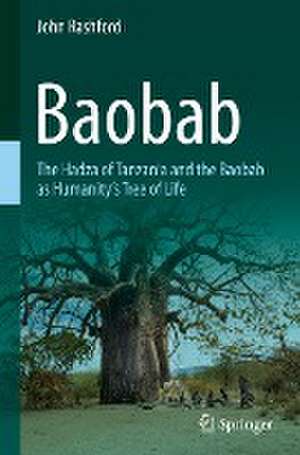Baobab: The Hadza of Tanzania and the Baobab as Humanity's Tree of Life
Autor John Rashforden Limba Engleză Hardback – 29 iun 2023
Preț: 1119.56 lei
Preț vechi: 1365.32 lei
-18% Nou
Puncte Express: 1679
Preț estimativ în valută:
214.23€ • 224.24$ • 178.31£
214.23€ • 224.24$ • 178.31£
Carte tipărită la comandă
Livrare economică 31 martie-14 aprilie
Preluare comenzi: 021 569.72.76
Specificații
ISBN-13: 9783031264696
ISBN-10: 303126469X
Ilustrații: XXIX, 382 p. 6 illus., 5 illus. in color.
Dimensiuni: 155 x 235 mm
Greutate: 0.75 kg
Ediția:2023
Editura: Springer International Publishing
Colecția Springer
Locul publicării:Cham, Switzerland
ISBN-10: 303126469X
Ilustrații: XXIX, 382 p. 6 illus., 5 illus. in color.
Dimensiuni: 155 x 235 mm
Greutate: 0.75 kg
Ediția:2023
Editura: Springer International Publishing
Colecția Springer
Locul publicării:Cham, Switzerland
Cuprins
Part I: THE BAOBAB.- Chapter 1. The distinguishing features of the tree of life and the baobab.- Chapter. 2. The Hadza and studies that document their use of the baobab.- Part II: THEORETICAL FRAMEWORK.- Chapter. 3. Hominin adaptation as the development of a gendered forager division of labor.- Chapter. 4. Correlated handiness and bipedality as the outcome of the multidimensional selective pressures of the forager way of life.- Part III: MATERIAL CULTURE AND TECHNOLOGY.- Chapter. 5. Africa’s premier fiber tree.- Chapter. 6. The baobab and container.- Chapter. 7. The baobab and fire in hominin evolution.- Part IV: ENVIRONMENTAL CONSIDERATIONS.- Chapter. 8. The baobab and Hadza acquisition, management and use of water.- Chapter. 9. Baobab seasonality.- PART V: BAOBAB RESOURCES: FOOD, HEALTH, AND EXCHANGE BENEFITS.- Chapter. 10. The Hadza preeminent fruit tree.- Chapter. 11. Baobab beverages.- Chapter. 12. Africa’s honey tree.- Chapter. 13. The baobab and birds.- Chapter. 14. The Hadza diet and the baobab as a source of other animal foods.- Chapter. 15. The baobab as a hunger-time tree of life.- Chapter. 16. The baobab and health.- Chapter. 17. The baobab and exchange.- Part VI: THE INSPIRATIONAL VALUE OF THE BAOBAB.- Chapter. 18. The baobab in Hadza inspirational life.- Chapter. 19. The baobab as a fertility tree.- Chapter. 20. Other inspirational uses of the baobab.- Chapter. 21. The baobab and danger.- Chapter. 22. The baobab and death.- Part VII. THE HADZA AND BAOBAB REGENERATION.- Chapter. 23. The baobab and Hadza central-place residential camps.- Chapter. 24. Hadza influence on baobab regeneration.- Chapter. 25. The Hadza baobab retreat.- Literature cited.- Index.
Recenzii
“In 25 well organized chapters, the author brings his nearly four decades of research on the topic … . The Hadza and Africa’s iconic baobab have co-inhabited the savanna for thousands of years. In rich detail, John Rashford’s Baobab makes a compelling case for the Hadza-baobab relationship to be highly representative of the dawn of human evolutionary history. ... I encourage readers to order this finely researched volume for their local library.” (Robert Voeks, Economic Botany, Vol. 78 (1), 2024)
Notă biografică
Prof. Dr. John Rashford is a retired professor emeritus of the College of Charleston in Charleston, South Carolina, who received his Ph.D. in Anthropology from the City University of New York. His research focuses on the ethnobotany of the Caribbean with a particular interest in the cultural importance of trees.
Textul de pe ultima copertă
Modern humans, descendants of a founding population that separated from chimpanzees some five to eight million years ago, are today the only living representative of a branching group of African apes called hominins. Because of its extraordinary size and shape, the baobab (Adansonia digitata L.) has long been identified as the most striking tree of Africa’s mosaic savanna, the landscape generally regarded as the environment of hominin evolution. This book makes the case for identifying the baobab as the tree of life in the hunter-gatherer adaptation that was the economic foundation of hominin evolution. The argument is based on the significance of the baobab as a resource-rich environment for the Hadza of northeastern Tanzania, who continue to be successful hunter-gatherers of the African savanna.
Caracteristici
Provides documentation for Baobab's global cultural significance Elucidates the popular interest in Baobab identified as the "tree of life" Fully describes Baobab for its food potential suitable for dry environments
